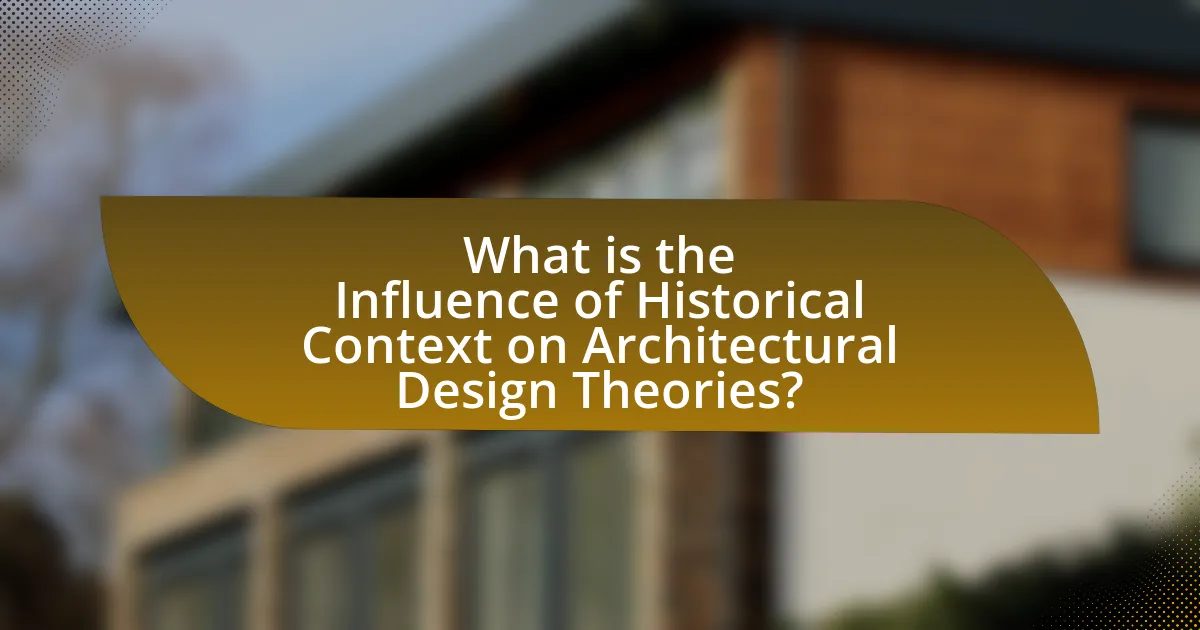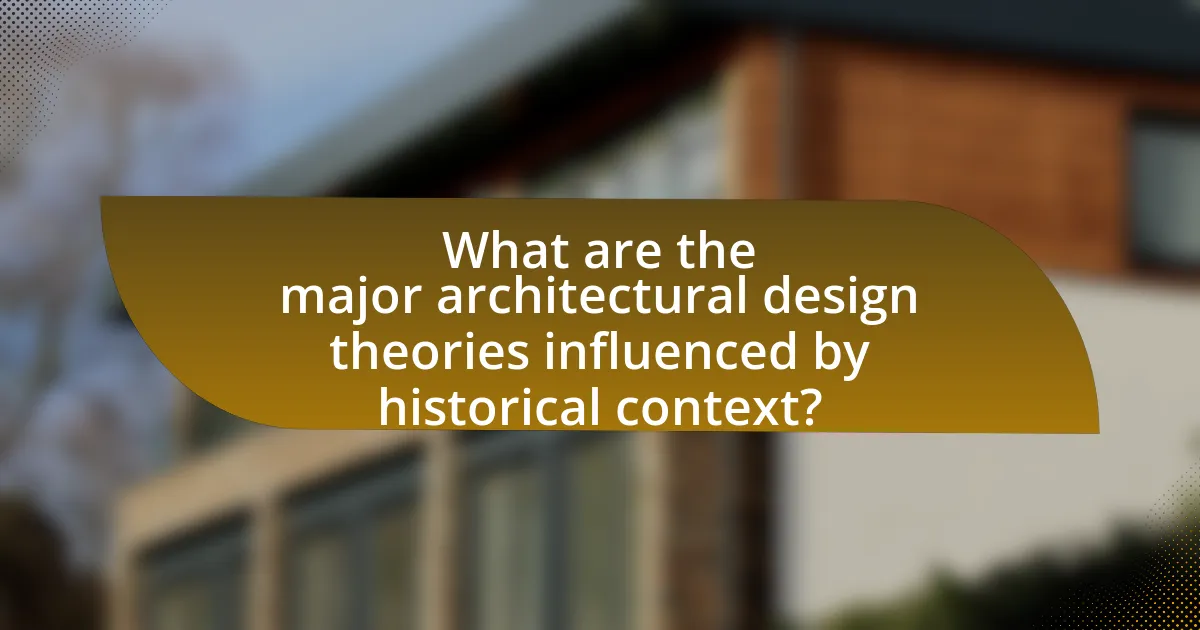The article examines the influence of historical context on architectural design theories, highlighting how societal values, technological advancements, and cultural movements shape architectural practices. Key historical events, such as the Industrial Revolution and the Renaissance, are discussed for their impact on design principles, materials, and construction techniques. The article also explores how cultural movements, like Modernism and Brutalism, reflect the socio-political climate of their times, emphasizing the importance of understanding historical context for contemporary architects. Additionally, it addresses the challenges and best practices for integrating historical influences into modern design, ultimately illustrating the ongoing relevance of historical context in shaping architectural ideologies.

What is the Influence of Historical Context on Architectural Design Theories?
Historical context significantly influences architectural design theories by shaping the values, technologies, and materials available during specific periods. For instance, the Industrial Revolution introduced new construction techniques and materials, such as steel and reinforced concrete, which led to the development of modernist architecture that emphasized functionality and simplicity. Additionally, cultural movements, such as the Gothic Revival in the 19th century, reflected a societal yearning for historical continuity and craftsmanship, impacting design principles and aesthetics. The context of World War II also prompted architects to rethink urban planning and housing, leading to the emergence of Brutalism, which prioritized social housing and community needs. These examples illustrate how historical events and societal shifts directly inform architectural ideologies and practices.
How does historical context shape architectural design theories?
Historical context significantly shapes architectural design theories by influencing the values, technologies, and materials available during specific periods. For instance, the Industrial Revolution introduced new construction techniques and materials, such as steel and reinforced concrete, which led to the development of modernist architectural theories that emphasized functionality and simplicity. Additionally, cultural movements, such as the Gothic Revival in the 19th century, reflected a societal yearning for historical continuity and craftsmanship, thereby shaping design principles that prioritized ornamentation and historical references. These examples illustrate how architectural theories are not only products of aesthetic preferences but also responses to the socio-economic and cultural conditions of their time.
What are the key historical events that have influenced architectural design?
Key historical events that have influenced architectural design include the Industrial Revolution, which introduced new materials and construction techniques, and the Renaissance, which revived classical architecture and emphasized symmetry and proportion. The Industrial Revolution, occurring in the late 18th to early 19th centuries, led to the use of steel and glass, enabling the construction of skyscrapers and large public buildings. The Renaissance, spanning the 14th to 17th centuries, marked a return to classical Greek and Roman principles, influencing structures like St. Peter’s Basilica in Vatican City. Additionally, the Modernist movement in the early 20th century rejected ornamentation and embraced functionalism, as seen in the works of architects like Le Corbusier and Ludwig Mies van der Rohe. Each of these events significantly shaped architectural practices and philosophies, reflecting the technological, cultural, and aesthetic values of their times.
How do cultural movements impact architectural styles and theories?
Cultural movements significantly shape architectural styles and theories by reflecting the values, beliefs, and aesthetics of the society from which they emerge. For instance, the Arts and Crafts movement in the late 19th century emphasized handcrafted quality and traditional craftsmanship as a reaction against industrialization, leading to architectural designs that prioritized natural materials and simplicity. Similarly, the Modernist movement in the early 20th century, influenced by the Industrial Revolution and the desire for functionalism, resulted in minimalist designs characterized by clean lines and the absence of ornamentation, as seen in the works of architects like Le Corbusier and Ludwig Mies van der Rohe. These movements demonstrate how societal changes, such as technological advancements and shifts in cultural values, directly inform and transform architectural practices and theories.
Why is understanding historical context important for architects?
Understanding historical context is crucial for architects because it informs design decisions that resonate with cultural, social, and environmental factors. Historical context provides insights into architectural styles, materials, and construction techniques that have evolved over time, allowing architects to create buildings that are not only functional but also meaningful within their specific locales. For instance, the use of local materials in traditional architecture reflects the historical availability of resources and climatic conditions, which can enhance sustainability and community identity. Additionally, knowledge of past architectural movements, such as Modernism or Gothic Revival, enables architects to draw inspiration and avoid repeating historical mistakes, ensuring that new designs are relevant and respectful of their surroundings.
How does historical context inform contemporary architectural practices?
Historical context informs contemporary architectural practices by providing a framework of cultural, social, and technological influences that shape design decisions. For instance, the revival of sustainable architecture reflects historical movements such as the Arts and Crafts movement, which emphasized craftsmanship and environmental harmony. Additionally, the use of local materials and traditional building techniques in modern designs often stems from historical precedents, as seen in the adaptation of vernacular architecture to meet current sustainability goals. This connection to history not only enriches the aesthetic and functional aspects of contemporary architecture but also fosters a sense of identity and continuity within communities.
What lessons can modern architects learn from historical architectural theories?
Modern architects can learn the importance of context, functionality, and cultural significance from historical architectural theories. Historical theories emphasize that architecture should respond to its environment and the needs of its users, as seen in the works of Vitruvius, who advocated for firmness, commodity, and delight. Additionally, the principles of Gothic architecture illustrate the significance of light and verticality, which can inspire contemporary designs that prioritize natural illumination and spatial experience. Furthermore, the lessons from the Bauhaus movement highlight the integration of art and technology, encouraging modern architects to embrace innovation while maintaining aesthetic value. These historical insights provide a foundation for creating architecture that is not only visually appealing but also socially and environmentally responsible.

What are the major architectural design theories influenced by historical context?
Major architectural design theories influenced by historical context include Modernism, Postmodernism, and Deconstructivism. Modernism emerged in the early 20th century, reflecting the industrial revolution and a break from traditional forms, emphasizing functionality and simplicity, as seen in the works of Le Corbusier and Ludwig Mies van der Rohe. Postmodernism arose in the late 20th century as a reaction against Modernism, incorporating historical references and eclectic styles, exemplified by architects like Robert Venturi and Michael Graves. Deconstructivism, gaining prominence in the 1980s, challenges conventional forms and embraces fragmentation, with figures like Frank Gehry and Zaha Hadid leading this movement. Each of these theories is deeply rooted in the socio-political and technological changes of their respective eras, demonstrating how historical context shapes architectural thought and practice.
How do different architectural movements reflect their historical contexts?
Different architectural movements reflect their historical contexts by embodying the social, political, and technological changes of their time. For instance, the Gothic architecture of the Middle Ages, characterized by pointed arches and flying buttresses, emerged during a period of religious fervor and the rise of cathedrals as centers of community life. Similarly, the Industrial Revolution gave rise to Modernism, which embraced new materials like steel and glass, reflecting the era’s technological advancements and a shift towards functionality over ornamentation. The Postmodern movement, emerging in the late 20th century, responded to the perceived limitations of Modernism by reintroducing historical references and eclectic styles, mirroring the cultural pluralism and skepticism of authority prevalent during that time. These examples illustrate how architectural styles serve as tangible expressions of the values, challenges, and innovations of their respective historical periods.
What are the characteristics of Classical architecture in relation to its historical context?
Classical architecture is characterized by its use of symmetry, proportion, and the incorporation of columns and pediments, reflecting the values of order and harmony prevalent in ancient Greek and Roman societies. This architectural style emerged during a period marked by advancements in mathematics, philosophy, and the arts, which emphasized rationality and beauty. The use of the Doric, Ionic, and Corinthian orders in columns exemplifies the Greeks’ pursuit of aesthetic perfection, while Roman adaptations introduced innovations such as the arch and dome, showcasing engineering prowess. These elements were not merely decorative; they symbolized civic pride and the cultural achievements of their respective civilizations, as seen in structures like the Parthenon and the Pantheon, which served both religious and public functions.
How did the Industrial Revolution alter architectural design theories?
The Industrial Revolution significantly altered architectural design theories by introducing new materials and construction techniques that emphasized functionality and efficiency. The widespread availability of iron and later steel allowed architects to create structures that were taller and more durable, leading to the development of skyscrapers and large public buildings. Additionally, the use of prefabricated components streamlined construction processes, enabling faster project completion. This shift towards industrial materials and methods marked a departure from traditional styles, as seen in the transition from ornate designs to more utilitarian forms, exemplified by the emergence of the Modernist movement in the late 19th and early 20th centuries. The integration of technology into architecture during this period fundamentally changed how buildings were conceived, designed, and constructed, reflecting the industrialized society’s values of progress and innovation.
What role does socio-political context play in architectural design theories?
Socio-political context significantly influences architectural design theories by shaping the values, priorities, and constraints within which architects operate. For instance, during the post-World War II era, the socio-political climate emphasized modernism and functionality in architecture, reflecting a desire for progress and rebuilding. This shift was evident in the widespread adoption of minimalist designs and the use of industrial materials, which were seen as symbols of efficiency and modernity. Additionally, socio-political movements, such as the civil rights movement in the United States, prompted architects to consider social equity in their designs, leading to the development of community-focused spaces that promote inclusivity. Historical examples, such as the Bauhaus movement, illustrate how socio-political ideologies can directly inform architectural principles, emphasizing the connection between societal needs and design approaches.
How do political ideologies shape architectural styles?
Political ideologies significantly shape architectural styles by influencing design principles, aesthetics, and the purpose of structures. For instance, totalitarian regimes often employ monumental architecture to convey power and control, as seen in the grandiose designs of Nazi Germany, which aimed to reflect the strength of the state through structures like the Reich Chancellery. Conversely, democratic ideologies may promote functionalism and accessibility in architecture, as demonstrated by the Bauhaus movement, which emphasized simplicity and utility in design to reflect egalitarian values. These architectural expressions serve as physical manifestations of the prevailing political beliefs, reinforcing the ideologies they represent through their form and function.
What examples illustrate the impact of socio-political movements on architecture?
The impact of socio-political movements on architecture is illustrated by the Bauhaus movement, which emerged in Germany in the early 20th century, advocating for a synthesis of art and technology in response to industrialization and societal change. This movement led to the creation of functional, minimalist designs that emphasized simplicity and utility, as seen in buildings like the Bauhaus School in Dessau, designed by Walter Gropius in 1926. Another example is the Brutalist architecture that arose in the post-World War II era, reflecting a desire for social reform and community-focused living, with structures like the Boston City Hall, completed in 1968, embodying the movement’s principles of raw concrete and bold forms. Additionally, the Civil Rights Movement in the United States influenced architecture through the design of community centers and public spaces aimed at fostering inclusivity and social justice, such as the Birmingham Civil Rights Institute, which opened in 1992, serving as a memorial and educational facility. These examples demonstrate how socio-political movements have directly shaped architectural styles and practices in response to the needs and values of society.

How can architects apply historical context to modern design practices?
Architects can apply historical context to modern design practices by integrating elements from past architectural styles and cultural significance into contemporary projects. This approach allows architects to create designs that resonate with local history and identity, fostering a sense of place. For instance, the use of traditional materials and construction techniques can enhance sustainability while paying homage to regional architectural heritage. Historical context also informs the spatial organization and aesthetic choices, as seen in the revival of neoclassical elements in modern civic buildings, which evoke a sense of permanence and authority. By studying historical precedents, architects can draw inspiration from successful designs, adapting them to meet current needs while preserving cultural narratives.
What strategies can architects use to incorporate historical context into their designs?
Architects can incorporate historical context into their designs by conducting thorough research on the architectural styles, materials, and cultural significance of the area they are working in. This involves analyzing historical documents, visiting local archives, and studying existing structures to understand the architectural lineage and community values. For instance, the preservation of local building materials and traditional construction techniques can enhance the authenticity of new designs, as seen in the restoration of historic districts where original materials are prioritized to maintain visual continuity. Additionally, architects can engage with local communities to gather narratives and insights that reflect the historical significance of the site, ensuring that new designs resonate with the cultural heritage and identity of the area. This approach not only honors the past but also creates a dialogue between old and new, fostering a sense of place and continuity in architectural practice.
How can historical context enhance the sustainability of modern architecture?
Historical context enhances the sustainability of modern architecture by providing insights into traditional building practices that prioritize local materials and climate-responsive designs. For instance, vernacular architecture often utilizes resources that are abundant in the region, reducing the carbon footprint associated with transportation and manufacturing. Additionally, historical methods of passive heating and cooling, such as thick walls and strategic window placement, can inform contemporary designs that aim to minimize energy consumption. Research indicates that integrating these time-tested strategies can lead to buildings that are not only environmentally friendly but also culturally relevant, fostering a sense of place and community.
What are the challenges of integrating historical context into contemporary architectural projects?
Integrating historical context into contemporary architectural projects presents challenges such as balancing modern design principles with historical authenticity. Architects often struggle to respect the original architectural styles and cultural significance while meeting contemporary functional and aesthetic demands. For instance, the preservation of historical buildings requires adherence to specific guidelines that can limit innovative design approaches. Additionally, there may be conflicts between modern materials and techniques and the traditional methods that define historical architecture, complicating the integration process. Furthermore, public perception and stakeholder interests can create tension, as communities may have differing views on the importance of historical context versus modern needs.
What best practices should architects follow when considering historical context?
Architects should prioritize thorough research of the historical context of a site to inform their design decisions. This involves analyzing the architectural styles, materials, and cultural significance of existing structures in the area. For instance, understanding the historical significance of a building can guide architects in preserving its character while integrating modern elements. Additionally, engaging with local communities and stakeholders can provide insights into the historical narratives that shape the identity of the place. By adhering to these practices, architects can create designs that respect and enhance the historical context, ensuring that new constructions harmonize with their surroundings and contribute positively to the cultural landscape.
How can architects balance historical influences with modern needs?
Architects can balance historical influences with modern needs by integrating traditional design elements into contemporary frameworks. This approach allows for the preservation of cultural heritage while addressing current functional and aesthetic requirements. For instance, the use of local materials and architectural styles can maintain historical context, as seen in projects like the Tate Modern in London, which repurposed a former power station while incorporating modern design principles. This method not only respects the past but also meets the demands of modern sustainability and technology, ensuring that new constructions resonate with their historical surroundings.
What resources are available for architects to study historical architectural theories?
Architects can study historical architectural theories through a variety of resources, including academic journals, books, online databases, and educational institutions. Academic journals such as the Journal of Architectural Education and Architectural Theory Review publish peer-reviewed articles that analyze historical theories and their implications. Books like “A History of Architecture” by Vincent Scully provide comprehensive overviews of architectural movements and their historical contexts. Online databases such as JSTOR and Google Scholar offer access to a vast array of scholarly articles and papers on architectural history. Additionally, many universities with architecture programs offer courses and lectures focused on historical architectural theories, providing structured learning opportunities. These resources collectively support architects in understanding the evolution of architectural thought and its historical significance.
